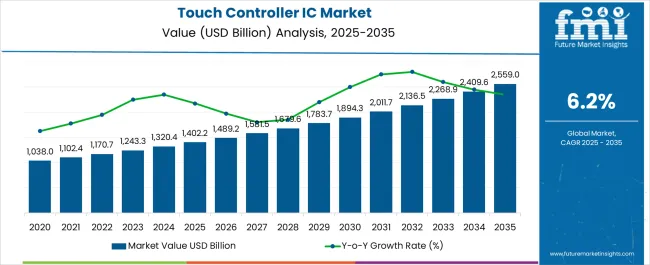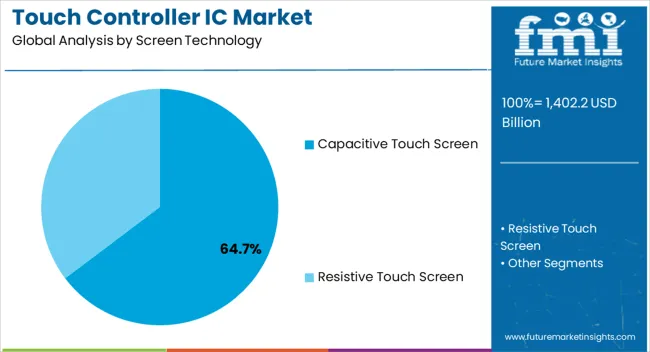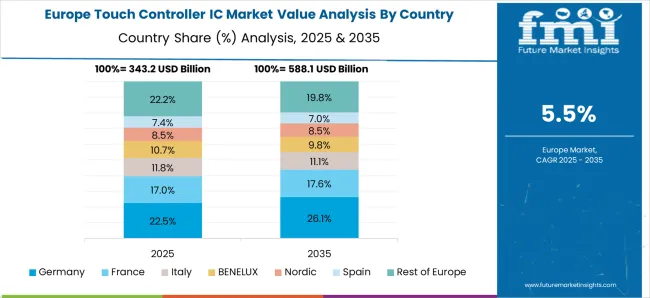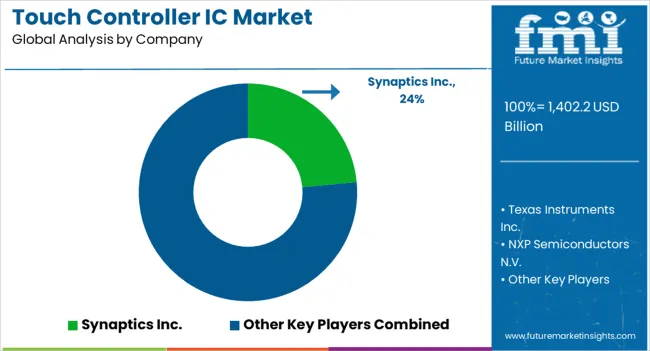The Touch Controller IC Market is estimated to be valued at USD 1402.2 billion in 2025 and is projected to reach USD 2559.0 billion by 2035, registering a compound annual growth rate (CAGR) of 6.2% over the forecast period.

| Metric | Value |
|---|---|
| Touch Controller IC Market Estimated Value in (2025 E) | USD 1402.2 billion |
| Touch Controller IC Market Forecast Value in (2035 F) | USD 2559.0 billion |
| Forecast CAGR (2025 to 2035) | 6.2% |
The touch controller IC market is expanding rapidly, fueled by the widespread adoption of smart devices, interactive displays, and automotive infotainment systems. Increasing consumer demand for seamless human machine interfaces has driven manufacturers to integrate advanced touch technologies that deliver high precision, multi touch capabilities, and responsiveness.
Capacitive sensing technologies are being preferred due to their durability, superior sensitivity, and compatibility with sleek device designs. Technological innovations such as low power consumption controllers and integration with flexible and foldable displays are further accelerating adoption.
Growing applications across consumer electronics, automotive, industrial automation, and healthcare are broadening the market landscape. The outlook remains strong as investments in next generation display technologies and digital transformation initiatives continue to reinforce demand for advanced touch controller ICs.

The capacitive touch screen technology segment is expected to represent 64.70% of the total revenue by 2025 within the screen technology category, positioning it as the dominant segment. Its leadership is driven by enhanced touch accuracy, ability to support multi touch gestures, and strong performance under varied environmental conditions.
Capacitive screens are valued for their sleek aesthetics, scratch resistance, and integration compatibility with high resolution displays, making them highly suitable for smartphones, tablets, automotive displays, and interactive kiosks. Additionally, the decline in component costs and advances in controller IC design have made capacitive solutions more affordable for mass deployment.
As industries prioritize user friendly interfaces and premium device experiences, capacitive touch technology continues to strengthen its market position as the most reliable and widely adopted solution.
From 2020 to 2025, a CAGR of 10.2% was registered for the touch controller IC sector. Market valuation expanded from USD 1038 million in 2020 to USD 1,213.3 million in 2025.
As market rivalry intensifies, suppliers are being forced to employ a variety of growth techniques.
This involves developing innovative products that, even before they are introduced, make competitors' products outdated and uncompetitive, in order to draw more attention to their own goods.
As a result, in order to be competitive in the market, the vendors are not only concerned with the technological improvement of their goods, but also with staying ahead of the competition from developing technologies.
One of the key reasons influencing the market growth is the rising demand for smartphones, together with the growing adoption of traditional touchscreen technology. Throughout the forecast period, the market is expected to expand due to the surging consumer electronics sector globally.
North America is projected to be at the forefront with a touch controller IC market share of 28.7% in 2025. The market growth is primarily fostered by the fact that North American users have a spending capacity and tend to adopt costlier devices faster than other geographies.
Moreover, the number of devices per user is expected to grow in the geography in the coming years, in turn driving the growth of touch controller IC in North America during the forecast period.

The touch controller IC sector in Europe is likely to hold a share of around 22.1% in 2025, with the leading growth in the area expected to be seen in Germany, France, the United Kingdom, and Italy in particular.
This is mostly on account of increased research and development efforts by businesses and the existence of significant market players committed to the development of capacitive technology and bringing about various developments, in turn expanding their market share.
Startups have received significant attention in various parts of the world in recent years, especially in regard to the market.
In the United States, the number of startups has rapidly expanded, and more assistance is now available in all aspects, facilitating the development of overall market growth.
Examples:
Capacitive imaging is used by the SigmaTouch Controller to produce user-friendly machine interfaces. SigmaSense technology provides access to a wide range of information about mobile device interactions, big size interactive displays, and specialized sensing applications.
Megahertz frequencies are used by MEMS-based technologies. It transmits and receives pressure wave signals through 5 mm of aluminum or glass, allowing it to detect tap strength while avoiding the necessity for cut outs or apertures in the enclosure.

The touch controller IC industry is fairly competitive, with key players involved in various strategies, such as mergers & acquisition, partnerships, collaborations, etc., in turn consolidating market position.
A couple of recent developments in the market are as follows:
The global touch controller IC market is estimated to be valued at USD 1,402.2 billion in 2025.
The market size for the touch controller IC market is projected to reach USD 2,559.0 billion by 2035.
The touch controller IC market is expected to grow at a 6.2% CAGR between 2025 and 2035.
The key product types in touch controller IC market are capacitive touch screen and resistive touch screen.
In terms of , segment to command 0.0% share in the touch controller IC market in 2025.






Full Research Suite comprises of:
Market outlook & trends analysis
Interviews & case studies
Strategic recommendations
Vendor profiles & capabilities analysis
5-year forecasts
8 regions and 60+ country-level data splits
Market segment data splits
12 months of continuous data updates
DELIVERED AS:
PDF EXCEL ONLINE
Touch Panel Market Size and Share Forecast Outlook 2025 to 2035
Touchless Sensing Market Size and Share Forecast Outlook 2025 to 2035
Touch Screen Film Market Size and Share Forecast Outlook 2025 to 2035
Touchless Tubes Market
Touchscreen Gloves Market
Touch Screen Module Market
Touchscreen Controller Market Growth - Trends & Outlook 2025 to 2035
Soft Touch Lamination Film Market Size and Share Forecast Outlook 2025 to 2035
Soft Touch Polyurethane Coatings Market Trends 2025 to 2035
Zero-Touch Provisioning (ZTP) Market - Growth & Demand 2025 to 2035
Soft Touch Film Market Analysis & Growth 2024-2034
Multi Touch Sensing Market Size and Share Forecast Outlook 2025 to 2035
Multi Touch Equipment Market Size and Share Forecast Outlook 2025 to 2035
Haptic Touchscreen Market Size and Share Forecast Outlook 2025 to 2035
Commercial Touch Display Market Size and Share Forecast Outlook 2025 to 2035
Automotive Touch Screen Control Systems Market Growth - Trends & Forecast 2025 to 2035
Capacitive Touchscreen Market Insights – Growth & Forecast through 2034
Predictive Touch Market Size and Share Forecast Outlook 2025 to 2035
Machine Tool Touch Probe Market Analysis - Size, Growth, and Forecast 2025 to 2035
Automotive Multimedia Touchpad Market Size and Share Forecast Outlook 2025 to 2035

Thank you!
You will receive an email from our Business Development Manager. Please be sure to check your SPAM/JUNK folder too.
Chat With
MaRIA